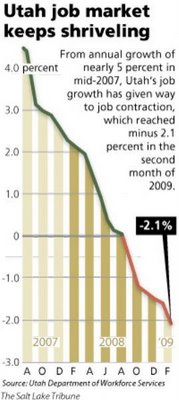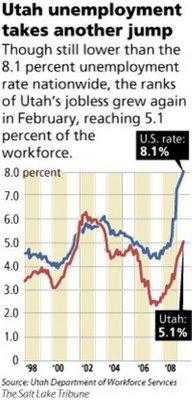Commercial Property Faces CrisisDelinquency Rate at 1.8%, Near Peak of Last Recession; Parallels to S&L Debacle
By LINGLING WEI, Wall Street Journal
Commercial real-estate loans are going sour at an accelerating pace, threatening to cause tens of billions of dollars in losses to banks already hurt by the housing downturn.
The delinquency rate on about $700 billion in securitized loans backed by office buildings, hotels, stores and other investment property has more than doubled since September to 1.8% this month,
according to data provided to The Wall Street Journal by Deutsche Bank Research. While that's low compared with the home-mortgage delinquency rate, it's just short of the highest rate during the last downturn early this decade.
Some experts say it now looks as if the current commercial-real-estate downturn will rival or even exceed the one in the early 1990s, when bad commercial-property debt played a big role in dragging the economy into a recession. Then, close to 1,000 U.S. banks and savings institutions failed. Lenders took about $48.5 billion in charges on commercial-real-estate debt between 1990 and 1995, representing 7.9% of such debt outstanding.
Foresight Analytics in Oakland, Calif., estimates the U.S. banking sector could suffer as much as $250 billion in losses this time. The research firm projects that more than 700 banks could fail as a result of commercial real estate.
General Growth Properties Inc., one of the biggest shopping-mall owners, has been teetering on the brink of a bankruptcy filing and recently failed to repay maturing loans on two shopping centers in Hayward, Calif., and Humble, Texas, according to Trepp, a firm that tracks the commercial property debt market.
John Hancock Tower in Boston is being sold in a foreclosure action. Recent additions to the list of properties with delinquent mortgages include an office building in Stamford, Conn., a hotel in Las Vegas and a shopping center in Ohio.
The problem was underscored when Moody's Investors Service downgraded Bank of America Corp. debt Wednesday, citing likely increases in soured "credit cards, residential and commercial real estate loans."
The Federal Reserve and the Treasury are moving to adapt a government funding program to make it attractive for investors to buy debt backed by office buildings, hotels, stores and other income-producing property. The program, called the Term Asset-Backed Securities Loan Facility, or TALF, was begun to finance purchases of debt backed by consumer credit and officials will expand its use to include commercial property debt.
Commercial-real-estate debt is potentially more dangerous to the financial system than loan classes such as credit cards and student loans because of its size. The Real Estate Roundtable estimates that commercial real estate in the U.S. is worth $6.5 trillion and financed by about $3.1 trillion in debt. The commercial real estate debt market is almost three times as big now as in the early 1990s.
Expanding the TALF program to commercial-real-estate loans would carry additional challenges. One is the commercial mortgages' duration, typically 10 years. The Fed is an institution that traditionally makes short-term debt available. In the TALF program, loans run just three years, which might not be long enough to spur investor demand for the longer-duration securities.
See the Data
Read the report provided to The Wall Street Journal by Deutsche Bank Research: "Commercial Real Estate Outlook Q1 2009."
Real-estate industry executives have been trying to resolve these issues with Fed and Treasury officials in meetings led by William Dudley, chief executive of the Federal Reserve Bank of New York, according to people familiar with the matter. The government officials are considering extending the TALF to accommodate the needs of the commercial-real-estate industry but no decisions have been made. In a statement on Monday, the Treasury Department suggested the Fed might alter the terms of its loans to investors to make them more attractive for long-term securities. "The Federal Reserve is working to ensure that the duration of these loans takes into account the duration of the underlying assets," the Treasury said.
Jeffrey DeBoer, chief executive of the Real Estate Roundtable, said, "The danger is a repeat of what happened on the residential side: A complete choking up, foreclosure disasters and increased stress on the banking system."
As recently as last summer, delinquency rates on commercial mortgages were at historically low levels. Many experts thought problems wouldn't be as bad in this downturn because commercial-property developers had showed more restraint.
But another issue is now looming: lax underwriting standards that some lenders used. Owners were able to borrow so much on the expectation that property values and cash flows would keep going up that some are at risk now that rents and occupancy rates are falling. Burdened by heavy debt loads, some commercial-property owners and developers are teetering, from General Growth to Broadway Partners, a privately held real-estate fund manager.
"In just seven months, we've gone from the best of times to the worst of times," said Richard Parkus, head of commercial mortgage securities research at Deutsche Bank AG.
Even some performing loans could face trouble because the values of the properties have fallen, making it hard for owners to refinance when loans come due. Currently, many banks are agreeing to grant short-term extensions on loans. But "that's just kicking the can down the street for awhile," said William Rudin, an owner of New York City office buildings. "That doesn't solve the problem."
Of some $154.5 billion of securitized commercial mortgages coming due between now and 2012, about two-thirds likely won't qualify for refinancing, Deutsche Bank predicts. Its estimate assumes declines in commercial-property values of 35% to 45% from the peak in 2007. That would exceed the price drops in the downturn of the early 1990s.
The bank estimates the default rates on the $700 billion of commercial-mortgage-backed securities could hit 30% and the loss rates -- which figures in the amounts recovered by lenders -- could reach more than 10% the highest levels seen in the last real-estate bust.
Besides securities backed by commercial-real-estate loans, about $524.5 billion of whole commercial mortgages held by the nation's banks and thrifts are expected to come due between this year and 2012. Between 40% and 45% of those loans wouldn't qualify for refinancing in a tight credit environment, as they exceed 90% of the underlying property's value, estimates Matthew Anderson, partner at Foresight Analytics. Today, lenders generally won't make loans that account for more than 65% of a property's value.
In contrast to home mortgages -- the majority of which were made by only 10 or so giant institutions -- hundreds of small and regional banks loaded up on commercial real estate. As of Dec. 31, more than 2,900 banks and savings institutions had more than 300% of their risk-based capital in commercial real-estate loans, including both commercial mortgages and construction loans. Risk-based capital is a cushion banks can dig into to cover losses.
At First Bank of Beverly Hills in Calabasas, Calif., , the amount of commercial-property debt outstanding was 14 times the bank's total risk-based capital as of the end of last year. Delinquencies reached 12.9%, compared with the average of 7% among the nation's banks and thrifts. Its lending is concentrated in Arizona, New Mexico and Nevada.
"In perfect hindsight, we would have done less commercial real-estate lending," said Larry B. Faigin, president and chief executive. The bank this month announced a deal with a leveraged-buyout and restructuring firm in Chicago, Orchard First Source Asset Management, under which Orchard will provide new capital to the bank.
Within two years after the deal closes, expected by August, First Bank will significantly reduce its concentration in commercial-real-estate lending and have less than half of its assets in the sector, Mr. Faigin said.
—Maurice Tamman and Jon Hilsenrath contributed to this article.
Write to Lingling Wei at lingling.wei@dowjones.com
Labels: Financing, National market
 But numbers don't tell the whole story.
But numbers don't tell the whole story.



